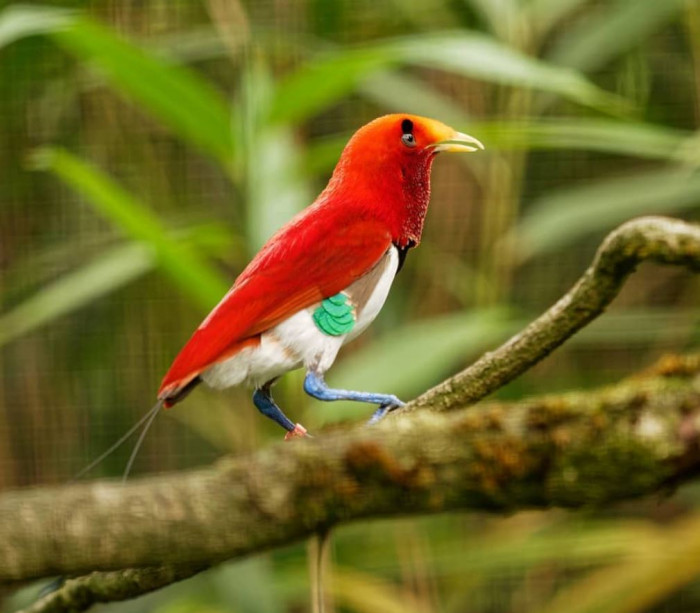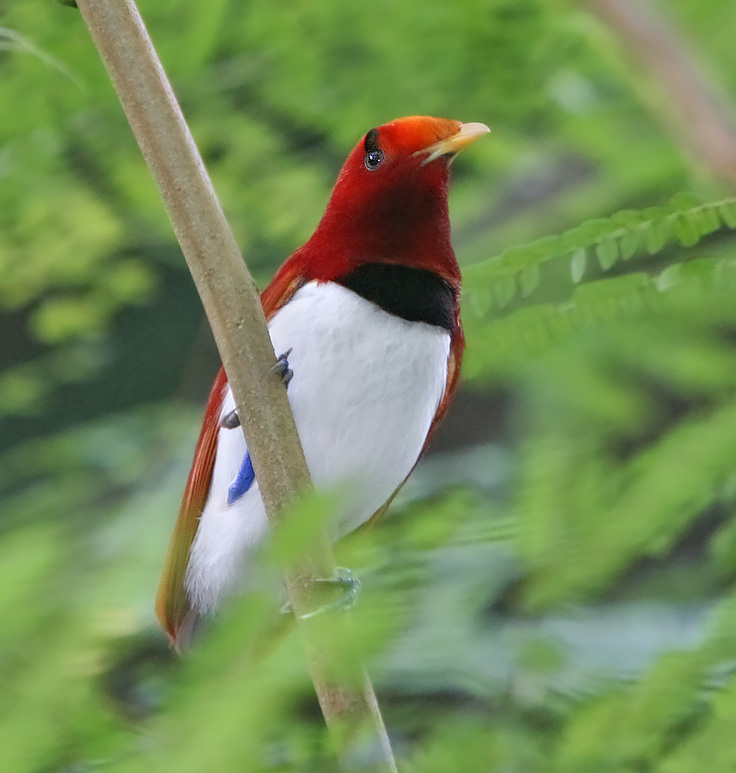The Cicinnurus regius, also known as the king bird-of-paradise, belongs to the passerine bird family called Paradisaeidae, which is mostly known for bird-of-paradise species. Although some authorities consider Diphyllodes to be closely related and subsumed under Cicinnurus, the IOC checklist considers it to be the only member of the Cicinnurus genus.

The king bird-of-paradise is a widely distributed species found in lowland forests of New Guinea and its surrounding islands. While they are known to inhabit higher elevations, not much is known about these populations yet. This bird is commonly referred to as the “living gem” due to its small size and vibrant colors. Adult males can measure up to 6.3-7.5 inches (16-19 cm) in length, but including their central rectrices, they can reach up to 12.2 inches (31 cm). Female king bird-of-paradise weigh around 0.08-0.13 pounds (36-59 g), while males weigh about 0.10-0.14 pounds (45-64 g).

The adult male King Bird-of-Paradise sports a metallic crimson hue with orange undertones in certain lights, and a green iridescent breast band that is narrow and dark. They also have fan-like plumes on their shoulders with green tips, olive-brown feathers on their undertail and mantle, and violet legs. Bills are colored ivory-yellow. On the other hand, females have less vibrant colors, with dull olive heads and upperparts, yellowish underparts, and violet legs. These birds can be found in lowland rainforests, gallery forests, and forest edges across New Guinea’s mainland and surrounding islands such as Aru, Salawati, Missol, and Yapen. They also inhabit disturbed and tall secondary forests.

The process of courtship and breeding for this species involves polygyny, where adult males participate in promiscuous behavior by displaying themselves either alone at exploded leks or in groups at traditional arboreal courts. These birds are known to be persistent callers and their courtship includes complex vocalizations, manipulation of feathers, and various body postures and movements, such as hanging fully inverted and swinging in a pendulum-like manner. The male performs an exceptional courtship display that includes swinging his tail, fluffing the white feathers on his abdomen to resemble a cotton ball, and performing acrobatic movements using his elongated tail wires.

During the months of March to October, breeding takes place for this particular bird species. What sets them apart from others in their family is that they build their open cup nest inside a tree cavity. The female takes charge of building the nest and raising the young without any help from the male counterpart. In captivity, it was observed that incubation lasted for approximately 17 days while the nestling period was around 14 days.
Their diet mainly consists of fruits and arthropods. They can be seen foraging at all levels of the forest, often joining mixed-species foraging flocks to search for arthropods in the lower regions of the forest.

The king bird-of-paradise is facing a decline in its population due to various factors such as habitat loss and hunting at unsustainable levels. Despite this, the species is still classified as Least Concern on the IUCN Red List of Threatened Species. Though their numbers are decreasing, they are still widespread and abundant throughout their large habitat range. The king bird-of-paradise is included in Appendix II of CITES.
